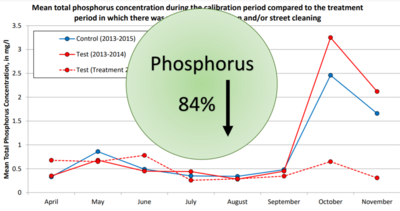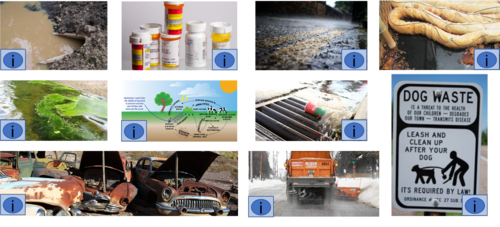
Difference between revisions of "Minnesota Stormwater Manual test page 5"
m () |
m () |
||
| Line 9: | Line 9: | ||
circle 3800 500 30 [[Organics in stormwater|Organics]] | circle 3800 500 30 [[Organics in stormwater|Organics]] | ||
circle 100 1000 30 [[Phosphorus|Phosphorus is a common constituent in urban stormwater. Sources include vegetative material (e.g. leaves), sediment from lawns, animal waste, fertilizers, road salt, lawn irrigation water, and other organic wastes. It is an essential element for plant life, but when there is too much of it in water, it can speed up eutrophication (a reduction in dissolved oxygen in water bodies caused by an increase of mineral and organic nutrients) of rivers and lakes.]] | circle 100 1000 30 [[Phosphorus|Phosphorus is a common constituent in urban stormwater. Sources include vegetative material (e.g. leaves), sediment from lawns, animal waste, fertilizers, road salt, lawn irrigation water, and other organic wastes. It is an essential element for plant life, but when there is too much of it in water, it can speed up eutrophication (a reduction in dissolved oxygen in water bodies caused by an increase of mineral and organic nutrients) of rivers and lakes.]] | ||
| − | circle | + | circle 1300 1000 30 [[Nitrogen in stormwater|Nitrogen]] |
| − | circle | + | circle 2850 1000 30 [[Trash in stormwater|Trash]] |
circle 3800 1500 30 [[Metals in stormwater|Metals]] | circle 3800 1500 30 [[Metals in stormwater|Metals]] | ||
circle 100 1500 30 [[Chloride in stormwater|Chloride]] | circle 100 1500 30 [[Chloride in stormwater|Chloride]] | ||
Revision as of 20:33, 12 July 2022
Warning: This page is an edit and testing page use by the wiki authors. It is not a content page for the Manual. Information on this page may not be accurate and should not be used as guidance in managing stormwater.
Information
Reporting phosphorus and TSS reduction credits from street sweeping

Research conducted by Bill Selbig (USGS) shows that streets, when cleaned of leaf litter prior to a storm, can significantly decrease phosphorus loads in stormwater runoff (Link to study)
At this time, the MPCA has not developed guidance for how to credit reductions in phosphorus or total suspended solid loading associated with enhanced street sweeping. We anticipate developing this guidance in 2022. In developing this guidance, consider the following.
- Baseline: Credits toward permit compliance, such as compliance with total maximum daily loads, can only be applied toward enhanced street sweeping. This is sweeping that results in pollutant reductions above pollutant reductions associated with sweeping that occurred at the baseline year.
- Accounting for seasonality: The image on the right illustrates the seasonal nature of phosphorus loading in areas where leaves and other organic sources are a source of phosphorus. Most models and other methods of estimating annual loads do not consider this seasonality and most likely significantly underestimates annual phosphorus loading. Accurate representation of impacts from enhanced street sweeping will require adjusting initial (baseline) calculations of loading. The MPCA is discussing appropriate methods for accounting for this seasonality.
- Downstream BMPs: Enhanced street sweeping potentially impacts loading to and performance of downstream BMPs. The MPCA is discussing if adjustments in downstream loading and/or adjustments in BMP performance are needed to accurately determine changes in phosphorus loading in areas where enhanced street sweeping is implemented.
Categories:
- Level 1 - Best Management practices
- Level 1 - Management
- Level 1 - Pollutants
- Level 1 - Regulatory
- Level 2 - Best management practices/Credits
- Level 2 - Best management practices/Design criteria
- Level 2 - General information and reference/Tables
- Level 2 - Pollutants/Phosphorus
- Level 2 - Pollutants/Bacteria
- Level 2 - Pollutants/Total suspended solids
- Level 3 - Pollutants/Phosphorus/Phosphorus in runoff
- Level 3 - Pollutants/Phosphorus/Managing phosphorus
- Test page
